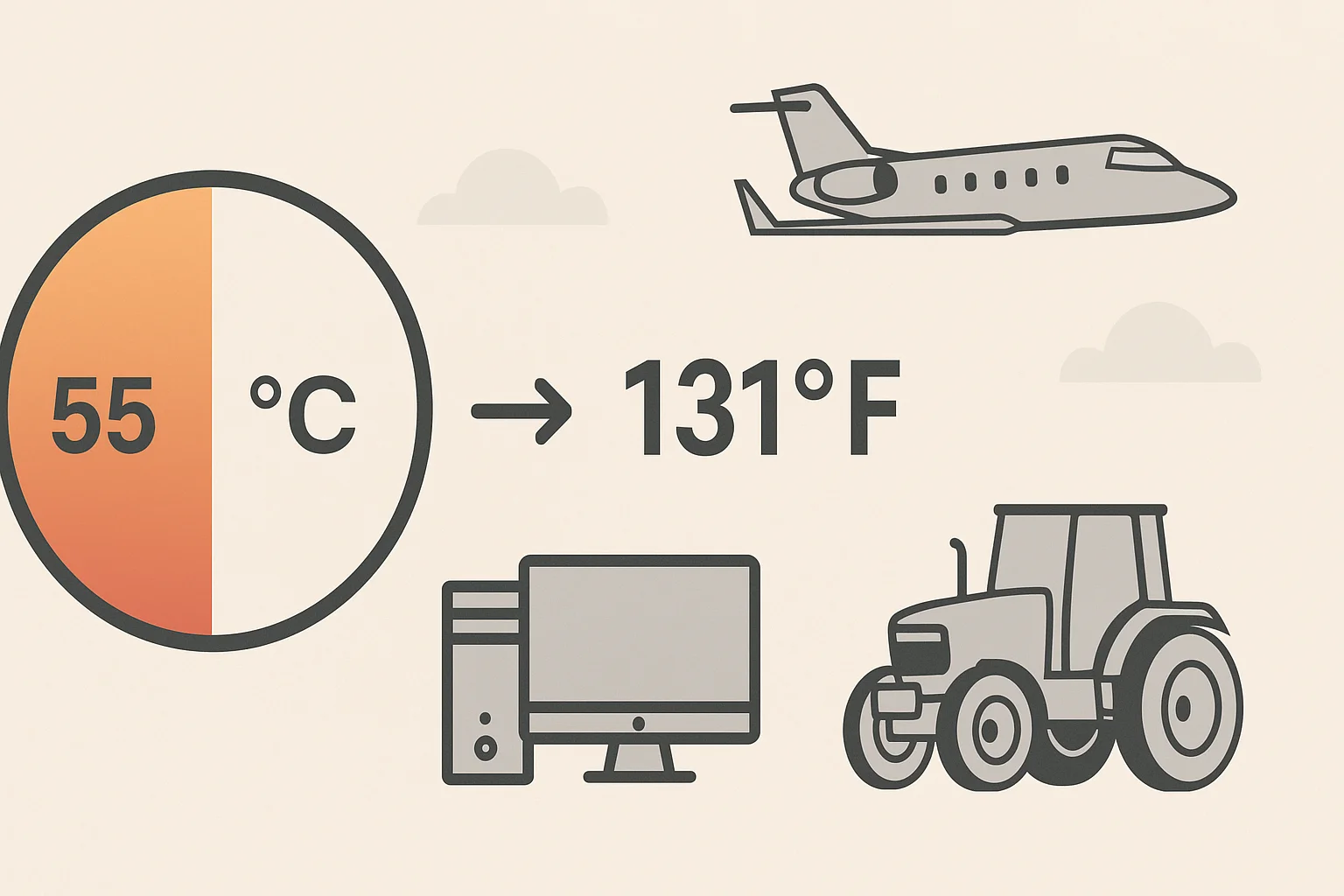Temperature is one of the most universal measurements we rely on in daily life, from the weather we experience to the performance of technology and machinery. When people ask about 55c to f, they’re usually seeking a clear understanding of what this Celsius value means in Fahrenheit and how it applies in different contexts. But this conversion is not just about math—it connects to aviation, computing, farming, and even high-end audio systems.
This article takes you beyond a simple formula. We’ll explain 55c to fahrenheit, explore its meaning in everyday scenarios, cover advanced applications in fields like aviation and agriculture, and even touch on how industries use this temperature benchmark for safety and efficiency.
What Does 55c to f Mean?
Converting 55c to f involves a straightforward formula:
F = (C × 9/5) + 32
So:
55c × 9/5 = 99
99 + 32 = 131
That means 55c in f equals 131°F.
This is the baseline answer for anyone wondering what is 55c in fahrenheit. In short: 55c in fahrenheit = 131°F.
Common Variations in the Conversion Search
When users type in 55c to farenheit or 55c in farenheit, they’re referencing the same concept. Spelling differences like “farenheit” instead of “fahrenheit” don’t change the math.
So whether you ask:
- 55c to fahrenheit
- 55c to farenheit
- 55c in f
- 55c in farenheit
- what is 55c in f
The answer remains: 131°F.
How Hot is 55c in Fahrenheit?
At first glance, 55°C might not sound extreme, but when you realize it equals 131°F, you understand the intensity. For humans, that’s dangerously hot—it’s hotter than most deserts ever reach. If you stood outside in 55c in f conditions, survival without protection would be nearly impossible.
This explains why people also ask about cold extremes like -55c to f, which equals -67°F. That’s brutal cold—enough to freeze skin in minutes. These extremes highlight the importance of mastering Celsius–Fahrenheit conversions.
55c in Technology – Is 55c Good for CPU or GPU?
One of the most common contexts for 55c to f searches comes from the tech community. People often ask:
- is 55c good for cpu?
- is 55c hot for a cpu?
- is 55c good for gpu?
Here’s the breakdown:
- A CPU running at 55c (131°F) is perfectly safe. Most CPUs can handle temperatures up to 85–95°C before throttling or damage occurs. So, if your processor is at 55°C, it’s considered healthy under load.
- For GPUs, the same logic applies. Graphics cards are designed to run hotter than CPUs, with many tolerating 80–85°C safely. So is 55c good for gpu? Yes—it’s an excellent, cool temperature.
Thus, for both CPUs and GPUs, 55c is within the safe, efficient range, far from danger zones.
Industrial Applications of 55c
Agriculture – Farmall 55c Tractor
The farmall 55c is a popular compact tractor. Its model name includes “55c” to indicate power classification, not necessarily temperature. Farmers often encounter operating ranges near 55°C in engines or hydraulics, and the tractor is designed to perform under such conditions without overheating.
Aviation – Learjet 55c and Learjet 55c/LR
In aviation, learjet 55c and learjet 55c/lr are aircraft models known for efficiency and endurance. Aircraft components often face temperature ranges like 55°C, which require strict monitoring. Pilots and engineers rely on conversion knowledge to assess performance in both Celsius and Fahrenheit.
Construction – Case 55c
The case 55c is a construction loader and backhoe model. Similar to farming equipment, machinery often works in environments where 55c in fahrenheit temperatures occur inside engines or hydraulics. Safety manuals frequently use both Celsius and Fahrenheit to prevent overheating mishaps.
High-End Audio and Technology References
The paradigm prestige 55c is a premium center-channel speaker in home theater setups. The “55c” in its name relates to the model, but heat management remains important for audio equipment. Ensuring systems don’t exceed safe ranges like 55c to f (131°F) is critical for longevity.
The dura12-55c/fr also ties into industrial electronics—often batteries, capacitors, or specialized equipment tested under temperature conditions up to 55°C. For engineers, knowing the equivalent in Fahrenheit ensures international safety compliance.
Scientific Context – 55c to K
Scientists often convert Celsius into Kelvin for precision. To find 55c to k:
K = °C + 273.15
So: 55 + 273.15 = 328.15 K
Thus, 55c to k equals 328.15 Kelvin.
This scale is crucial in physics, chemistry, and material sciences, where Celsius and Fahrenheit don’t provide the necessary absolute references.
Everyday Examples of 55c to Fahrenheit
- Cooking: While most oven settings are higher, certain recipes (like sous-vide cooking) use around 55°C (131°F) to prepare delicate meats.
- Weather: Some Middle Eastern deserts can approach 55°C, which translates to unbearable 131°F heat.
- Technology: As covered, CPUs, GPUs, and machinery often hover around 55c in f during performance testing.
- Automobiles: Engine compartments frequently reach internal temps of 55c to fahrenheit or higher, necessitating robust cooling systems.
Why Knowing Celsius and Fahrenheit Conversions Matters
The world is split: most countries use Celsius, but the U.S. uses Fahrenheit. For industries like aviation, computing, and agriculture, clarity is essential. Misunderstanding the difference between 55c in f and 55c in fahrenheit could mean overheating an engine, mismanaging a server, or misjudging safety.
In global collaboration, especially across science, technology, and manufacturing, mastering conversions like 55c to farenheit ensures accuracy and prevents costly errors.
Real-World Question and Answer
Is 55c hot for humans?
Yes, 55c to f is 131°F—well above survivable heat for humans outdoors.
Is 55c safe for electronics?
For CPUs and GPUs, yes. For some industrial batteries or delicate sensors, it can be borderline high. Always check manufacturer ratings.
Why do so many machines have “55c” in their model names?
It’s often just a series or classification code, like farmall 55c, case 55c, or paradigm prestige 55c, but engineers also factor in how components perform around 55°C.
FAQs
Q1: What is 55c to f in simple terms?
55°C equals 131°F. It’s hot for humans but safe for many machines.
Q2: Is 55c good for cpu temperatures?
Yes, is 55c good for cpu—it’s a safe and efficient operating temperature.
Q3: What is -55c to f?
That equals -67°F, an extremely cold and dangerous temperature.
Q4: How do you convert 55c to k?
Add 273.15: 55c to k = 328.15 Kelvin.
Q5: Why do machines like farmall 55c and case 55c use “55c” in their names?
It’s usually a classification model number, though it often overlaps with temperatures relevant to performance and safety.
Conclusion
The conversion of 55c to f is more than just a number—it’s a gateway into understanding how different industries, technologies, and daily life interact with temperature. At 131°F, 55°C represents a critical benchmark: deadly for humans, safe for high-performance CPUs and GPUs, and a reference point in aviation, agriculture, and construction machinery.
Whether you’re asking is 55c hot for a cpu, exploring the learjet 55c, checking the farmall 55c tractor, or even setting up a paradigm prestige 55c speaker system, knowing what 55c in fahrenheit means can make a difference in safety, efficiency, and understanding.


